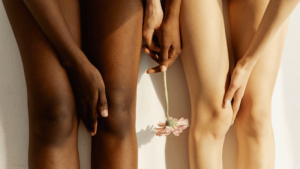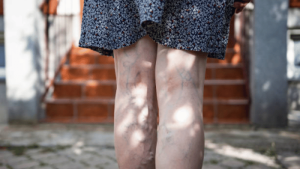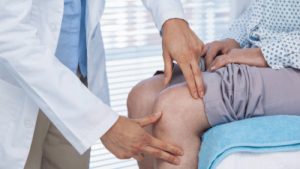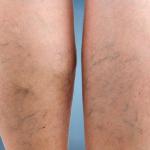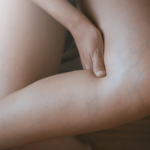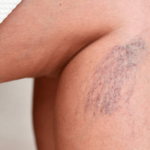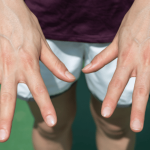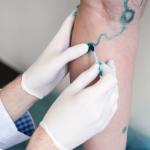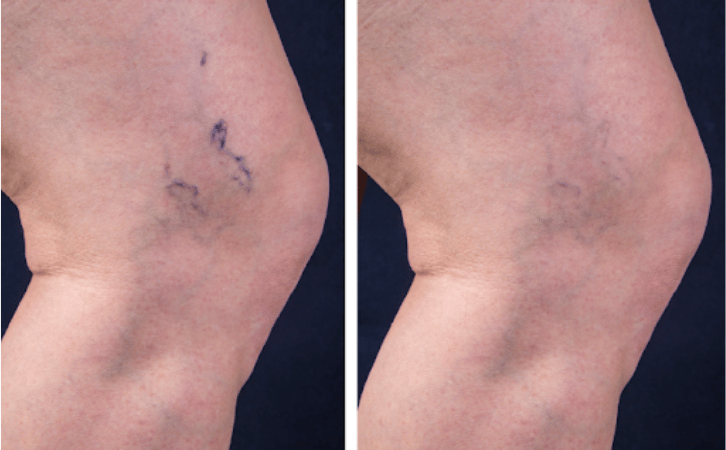
Veins look blue beneath the skin for several reasons, including skin tone, age, and vein health. The way light reflects off your skin also impacts the color of your veins, making them appear blue or other colors.
It may be more difficult to see the color of your veins if you have a darker skin tone, as blue veins may not be as visible on darker skin compared to lighter tones. However, if veins become more prominent, their size might be more noticeable regardless of skin tone.
Veins are blood vessels that carry blood back to the heart. The veins in your legs pump blood in one direction: up. This flow against gravity is facilitated by tiny, delicate valves that act as one-way doors for blood flow.
Valves can become damaged for a number of reasons, including age, inflammation, and a sedentary lifestyle. Damaged valves can cause blood to flow back, pooling in the leg veins. This backflow stretches the vein walls, causing raised, bulging varicose veins. These veins often appear blue or blue-purple in people with fair skin.
However, if your blue veins are also raised, it can be a sign of a vein disease. Bulging blue veins, known as varicose veins, are a symptom of vein disease called chronic venous insufficiency and should be evaluated by a vein specialist.
In this guide, we examine the science behind blue veins, explore potential causes, explain when to see a vein doctor, and discuss available treatment options.
The Science Behind Blue Veins
Because veins often appear blue, some think blood turns blue when it lacks oxygen and travels through veins. But in fact, blood with less oxygen, called deoxygenated, is darker but still red.
Why Do Veins Look Blue if the Blood Flowing Through Them Is Red?
The blue color we see when we look at veins under the skin is due to the way light interacts with the body’s tissues.
Visible light consists of the full-color spectrum, from red to blue and violet. Every color has a different wavelength, with red having the longest wavelength and blue and violet having the shortest. Long wavelengths have an easier time passing through translucent materials, like some people’s skin.
But our eyes only perceive the wavelengths that reflect back when light hits an object.
When skin is a lighter color, red light, with its long wavelengths, can easily pass through it. But the short wavelengths of blue light are quickly filtered out. Only longer wavelengths like red can reflect back through layers of skin.
Where veins are just below the skin, light that hits the veins is less filtered, and the light that reflects back still contains blue wavelengths. So these parts of the skin appear more blue compared to the surrounding skin.
Ultimately, it’s the science of light that makes veins appear blue, but there is still more to the story. Different factors can cause blue veins to look more prominent.
Varicose Veins in African American and Black Skin
Varicose veins can affect individuals of all skin colors, including African Americans and people with darker skin tones. While blue veins may be less visible on darker skin, varicose veins can still present noticeable symptoms. For those with dark skin, varicose veins might not appear as prominently blue but may manifest as bulging or raised veins, swelling, and skin texture changes.
Signs to Look Out For:
- Swelling and Bulging: Even if the veins are not visibly blue, swollen and bulging veins are key indicators.
- Skin Discoloration: In darker skin, this may appear as darker patches rather than the typical reddish or bluish hue seen in lighter skin.
- Pain and Heaviness: Experiencing discomfort, heaviness, or throbbing pain in the legs can indicate vein issues, regardless of skin color.
- Itchiness and Slow-Healing Wounds: Pay attention to itchy skin and any wounds that are slow to heal, as these can be symptoms of underlying vein problems.
If you notice any of these symptoms, it’s important to consult with a vein specialist who can provide an accurate diagnosis and recommend appropriate treatment options.
Common Causes of Blue Veins
While the properties of light are the main cause of blue veins, the following factors can impact the way veins look, including the color.
Genetics
If you have a family history of varicose veins, you’re more likely to develop damaged veins, which are easier to see when they become raised. As a result, you’re more likely to notice raised blue veins.
Skin Tone
Fairer skin tones make it easier to see the color of your veins because the skin is lighter, allowing more light to pass through and reflect off veins under the skin.
In darker skin, less light makes it to the veins, so blue veins are less visible.
Blood Oxygen Levels
Blood oxygen levels are the amount of oxygen circulating in the blood. When oxygen levels dip, which can happen when breathing air with less oxygen at high altitudes or because breathing is too slow or shallow, the normally oxygenated blood vessels can become a darker color, like veins. This can contribute to the bluish tint that may be seen on the skin and fingernails, along with an impact on leg function and mobility.
Vein Positioning and Depth
Veins closer to the surface of the skin are easier to see. Deeper veins aren’t visible, but if they are damaged, they can still cause symptoms like swelling or aching pain in the legs.
Age and Skin Changes
Age causes the skin to thin with time. Over the years, it loses fat, making it appear less plump, and making veins beneath the skin more visible.
Schedule a Consultation Online Today
Blue vs. Green Veins
The color of your veins—blue veins or green veins?—is primarily determined by your skin’s undertone. People with cool undertones tend to see blue veins, while those with warm undertones see green veins. This is due to the balance of pigments in your skin. Melanin is the major pigment affecting skin color:
- Pheomelanin gives a warm undertone- meaning it has a yellow or peach tint.
- Eumelanin is a cooler undertone- it has a blue or violet tint.
Importantly, the color of your veins doesn’t indicate vein health. However, if your veins become noticeably larger or more prominent over time, consult a vein specialist to rule out any underlying conditions.
When Blue Veins Might Indicate a Health Issue
While the blue color itself isn’t a sign of a health issue, raised, bulging, or prominent blue veins might be a sign of vein disease.
The most common type of vein disease, chronic venous insufficiency, is caused by damaged vein valves. It causes varicose veins and spider veins, as well as discomfort, skin changes, and leg swelling.
If you have blue veins and you notice any of the following symptoms, it’s a good idea to have your veins checked out by a vein specialist. A vein doctor can evaluate and determine if you have vein disease and recommend the best treatment for your veins.
Symptoms to watch for if you have blue veins include the following:
- Swelling of the feet, ankles, or legs
- Calf cramps, especially at night or while sitting for long periods
- Itchy skin
- Skin discoloration
- Throbbing or aching pain in the legs
- Leg heaviness
- Wounds on the legs that heal slowly or won’t heal
These are all symptoms of vein disease and may require consulting with a vein specialist. If left untreated, vein disease can lead to more severe symptoms, including venous ulcers. It also increases the risk of developing dangerous blood clots, such as deep vein thrombosis (DVT).
Concerned About Blue Veins? Get Expert Care
If your veins are bulging, stretched, or causing discomfort, this could be vein disease. Other symptoms include leg pain, heaviness, and swelling. Don’t ignore these warning signs.
USA Vein Clinics offers advanced treatments for vein conditions. Our team of highly experienced vein doctors provides personalized care and minimally invasive solutions. Schedule a consultation at a clinic near you today and take the first step towards healthier legs.
Frequently Asked Questions
What do blue veins mean?
Veins might appear blue because of how the light interacts with the skin and its pigments. The blue color itself isn’t a sign of a concern for vein health. Blue veins that are more visible, raised above the skin, or accompanied by other vein symptoms, however, are a sign of vein damage that should be evaluated by a vein doctor.
What do varicose veins look like on dark skin?
Varicose veins on dark skin might not appear as prominently blue but can present as raised or bulging veins. Skin discoloration may appear as darker patches rather than the typical reddish or bluish hue seen in lighter skin tones.
How can I identify varicose veins if I have a darker skin tone?
Look for symptoms such as swollen and bulging veins, skin texture changes, pain, leg heaviness, itchiness, and slow-healing wounds. These signs can indicate varicose veins even if the color is less noticeable.
What color are unhealthy veins?
Unhealthy veins are veins that have become damaged and can no longer pump blood effectively back to the heart. They can be green, blue, or even purple, depending on your skin tone. The color itself does not indicate the problem, but damaged veins should still be treated by an experienced vein specialist.
What should I do if I have blue veins on my legs?
If you have blue veins on your legs that are bulging or more visible than other veins, you should consult with a vein specialist. They can screen you for vein disease and recommend a treatment plan to help restore your vein health.
What are tips for healthy veins?
Bulging, blue varicose veins do require treatment. However, there are many ways to improve vein symptoms before and after treatment.
- A healthy, high-fiber diet can help to lower blood pressure and prevent weight gain — both high blood pressure and excess weight can increase vein damage.
- Regular exercise can improve blood flow and strengthen muscles to support leg veins.
- Staying hydrated can keep blood flowing freely through the veins.
- Regular vein check-ups can help you identify vein health issues so you can get the treatment you need early on.

